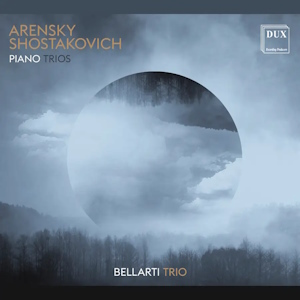
Anton Arensky (1861-1906)
Piano Trio No. 1 in D minor, op. 39 (1894)
Dmitri Shostakovich (1906-1975)
Piano Trio No.2 in E minor, op. 67 (1944)
Bellarti Trio
rec. 2021, Concert Hall of the Feliks Nowowiejski Warmia and Masuria Philharmonic, Olsztyn, Poland
DUX 1860 [62]
The Bellarti Trio was founded in 2004 in London by pianist Agnieszka Panasiuk, cellist Pawel Panasiuk (it is not clear whether they are siblings, husband and wife or no relation at all) and violinist Chihiro Inda. A couple of recordings were made for obscure labels which are almost certainly defunct, and by the time the Panasiuks released a disc of Icelandic chamber music on DUX in 2019 (review), the trio’s name had disappeared and the violinist was Anna Wandtke. With this new release, the Bellarti name returns together with Wandtke. Somewhat puzzling.
The obvious link between the two works on the programme is the heritage of their composer; they differ significantly in style and atmosphere, but not in quality. The Shostakovich vies with the Ravel for the best trio written in the 20th century, while the Arensky is one of the best trios not written by a major composer. It has been recorded more than fifty times, which makes it his most recorded work by some margin.
The Bellarti Trio takes a full two minutes more on the opening Allegro moderato than my preferred version of the Arensky (Trio Wanderer), and it does tend to drag somewhat. In this, they are similar to the Leonore Trio (Hyperion). Things are better in the Scherzo and while the Elegia is slower than any of my other versions, it is quite effective and affecting. With the closing Allegro non troppo, the problem of the opening movement returns. So a rather mixed bag.
The tempos adopted in the first three movements of the Shostakovich are around the norm, but the closing Allegretto is slower than most, though not the Borodin Trio (Chandos). Where the Bellarti performance misses out is a lack of bite: this is a work written towards the end of World War II, with Shostakovich despairing at the fate of the Jews. For me, a performance needs to express that anger and despair, and I don’t hear it enough of it here. Mind you, I have read much praise for the Borodin Trio’s very slow version, and I don’t hear much despair or anger there either. If you like that recording, you may well find this one to your taste. I wasn’t convinced; for an outstanding modern performance, I would suggest the Briggs Trio (Avie – review)
I found the sound to be quite dry, especially at high volumes, and it made listening rather tiring. The Arensky particularly features a good deal of sniffing, which became a little distracting. The sound issues don’t help with performances which are a little under-characterised, missing some of the romantic passion in the Arensky and the harrowing bitterness in the Shostakovich.
David Barker
Help us financially by purchasing from




















